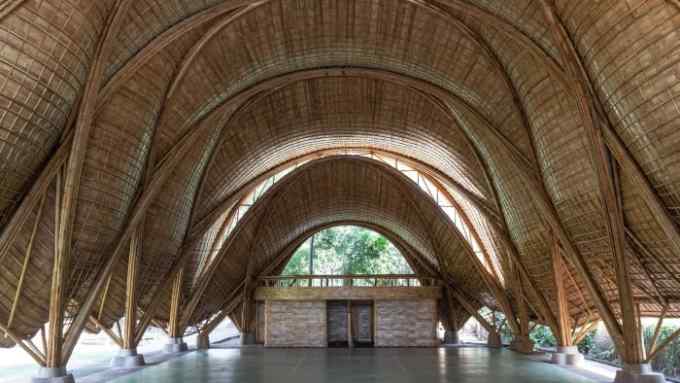The artistic enigma of the tree

Roula Khalaf, Editor of the FT, selects her favourite stories in this weekly newsletter.
“And when it rains we bathe in tree smells – raindrops are seeded from clouds by aromatic molecules that trees send to the skies,” writes David George Haskell in his 2021 series of essays, Thirteen Ways to Smell a Tree. It is a wonderful example of trees’ intelligence: both life-affirming and poetic. And how they can also bring joy. Joan Mitchell’s abstract trees are jubilant slabs of colourful, rhythmical brush strokes brimming with nature’s spirit. These works, like their subjects, are mood-lifters. Speaking in 1986, Mitchell recounted a spell in hospital where two trees entirely saved her mood. “When I was sick they moved me to a room with a window, and suddenly through the window I saw two fir trees in a park and the grey sky and the beautiful grey rain, and I was so happy,” she said. “It has something to do with being alive. I could see the trees and I felt I could paint.” (Conversely, the outrage and sadness last month over the felling of the tree at Sycamore Gap, which had stood by Hadrian’s Wall for centuries, is a different reminder of how much we care.)


This autumn offers a slew of tree-related art, from Philip Guston’s fleshy, perky, cartoonish trees in his ’70s Roma series at Tate Modern (until 25 February) to Ed Ruscha’s 1971 A Few Palm Trees at MoMA (until 13 January), a sublime exercise in trees as photographic minimalism. Phoebe Boswell’s A Tree Says [In These Boughs The World Rustles] at Orleans House Gallery in Twickenham (until 5 November) promises to be an inside/outside immersive experience of polyphonic soundscapes and interactive sculpture, while Henry Taylor’s One Tree Per Family (2023) – trunks topped with mops of synthetic foliage – is now at Hauser & Wirth in Paris (until 7 January). Next week, Jake Grewal, who often paints trees with queer figures – his The Sentimentality of Nature (2022) was acquired by The Hepworth Wakefield through the JW Anderson Collections Fund this year – will show new work in his Some Days I Feel More Alive exhibition at Pallant House Gallery. They all follow in such eminent footsteps as those of Vincent Van Gogh, who was obsessed with trees: a show at the Met in New York earlier this year featured 24 paintings depicting cypresses, including the classic Starry Night, captured in his signature swirls of oil.


“Trees are fundamental,” says Charlotte Gyllenhammar, whose 1993 Die For You, an oak weighing nearly two tonnes hanging above Stockholm’s equivalent of London’s Oxford Street, is being reprised in its 30th anniversary year (until early November). “They are almost like a human form and I think that’s why I identify with them.” Gyllenhammar has been asked countless times to restage this multilayered work. “Some thought it was about the environmental crisis, and you can interpret it in many ways, but my thinking is around place and architecture, memories, recent Swedish history,” she says. The tree, as before, has been taken from a farmer’s land in the Stockholm archipelago, from a location currently being cleared. For Gyllenhammar the piece is ultimately hopeful; she will also create a permanent work with the tree following its two-month installation.
The Garden Museum in south London’s current Frank Walter show (until 25 February) celebrates the artist’s Antiguan heritage. In one landscape, Trees with Upturned Leaves in Hurricane Sky, captured in explosive pink and green, you can all but feel the storm brewing. There’s a similar mood at the Louisiana Museum of Modern Art in Denmark (until 18 February) where Firelei Báez’s How to Slip Out of Your Body Quietly conjures a chorus of Ciguapa – a mythological creature of Dominican folklore – whose very movement seems to be whipping wind through a forest of palms. “Trees can be exotic,” says Emma House, curator at The Garden Museum, citing Henri Rousseau’s Tiger in a Tropical Storm as her own favourite example. “I’ve never seen a tiger in the wild, but I’ve stood under a tree in a rainstorm and experienced that power of nature.”


Giuseppe Penone, currently showing at Gagosian Paris (until 22 December), makes physical interactions with trees central to his practice. “For me, it is an example of a perfect sculpture,” says the artist. “In the tree, nothing is superfluous.” In Space of Light (2008), multiple bronze trunks were created by adding wax to a living tree, recording the imprint of the artist’s own hand and the tree’s bark so that the final work became a conversation.

![A Tree Says [In These Boughs The World Rustles], by Phoebe Boswell](https://www-ft-com.ezproxy.cul.columbia.edu/__origami/service/image/v2/images/raw/https%3A%2F%2Fd1e00ek4ebabms.cloudfront.net%2Fproduction%2F34c457b7-534e-42c3-8c04-f9cd1ef28e7d.jpg?source=next-article&fit=scale-down&quality=highest&width=700&dpr=1)
A work by Penone resides at Yorkshire Sculpture Park, home to a plethora of tree-related art, including works by David Nash and Hemali Bhuta. “There is evidence that trees do communicate through what has been dubbed ‘the woodland wide web’,” says Helen Pheby, associate director of programme. “Trees significantly alter the experience of space and scale. They really do each have their own place and character. When one reaches the end of its life, its loss creates collective grief.”
Philip Larkin’s 1974 poem “The Trees” posits that seasonal renewal is a form of grief. In a park in north London, several years ago, I bought a bench to commemorate the death of my boyfriend Peter. It sits opposite a rather majestic tree. Sometimes, when it’s bathed in early autumnal light, the goosebumps quicken. I had never wanted a grave but this tree marks the seasons with elegance, never failing to offer hope.

Comments